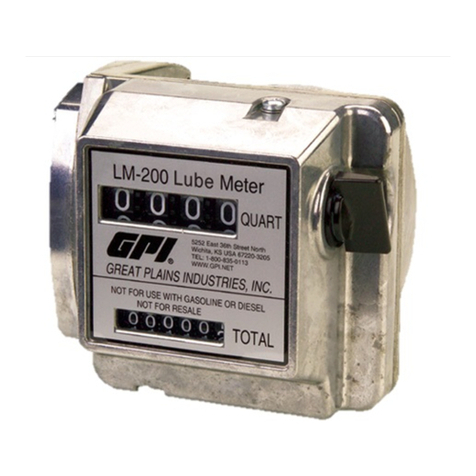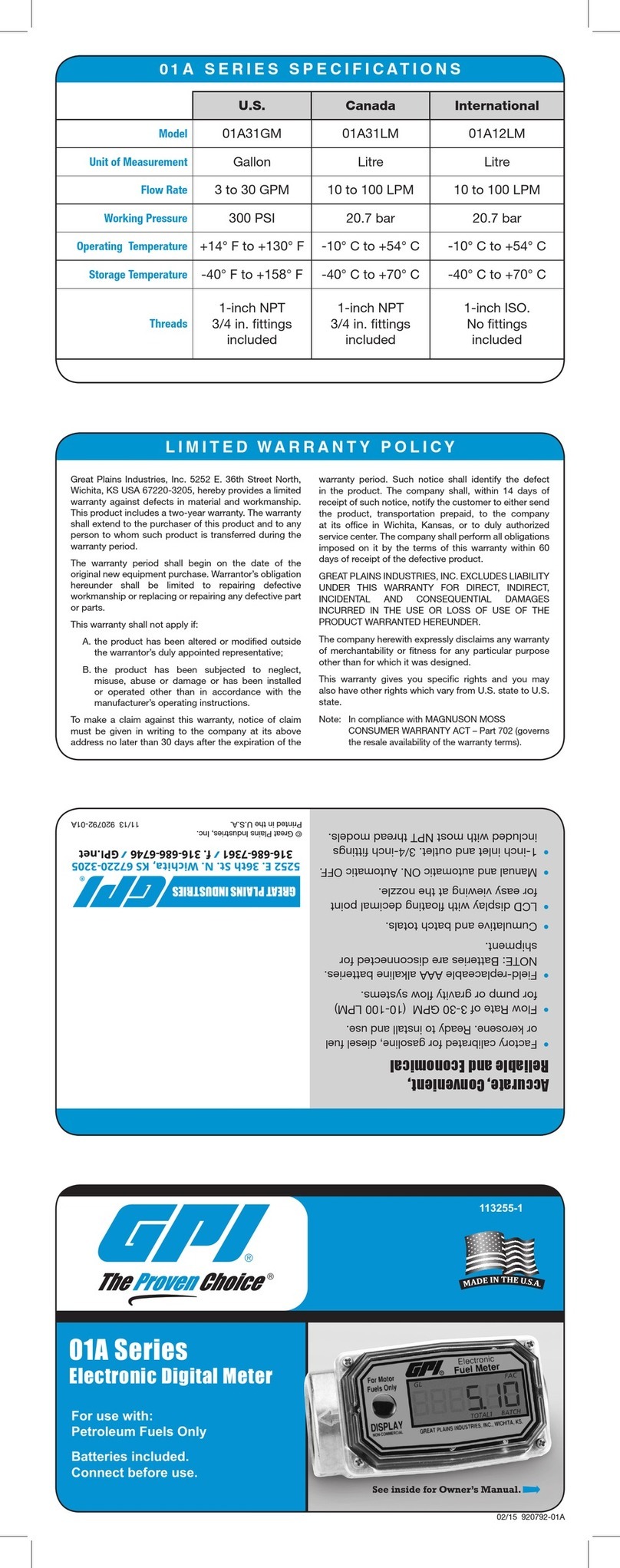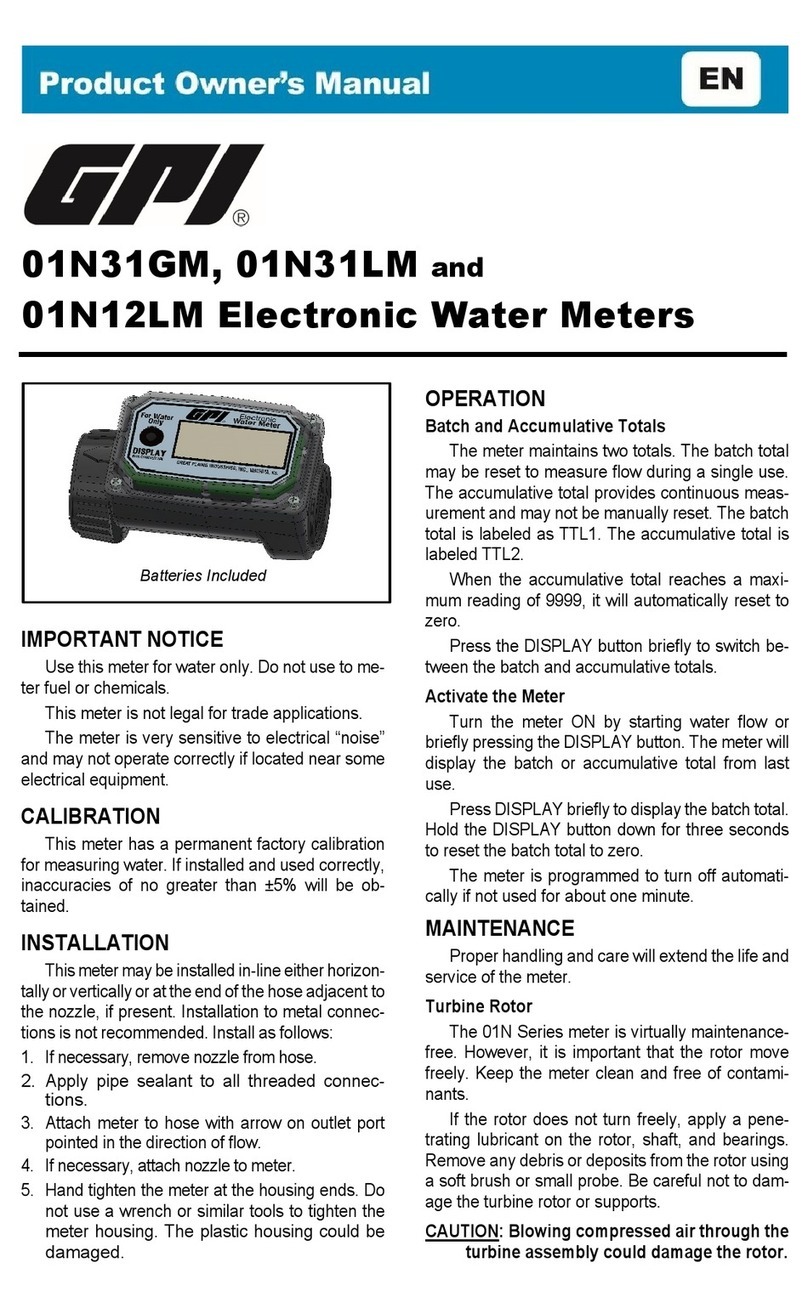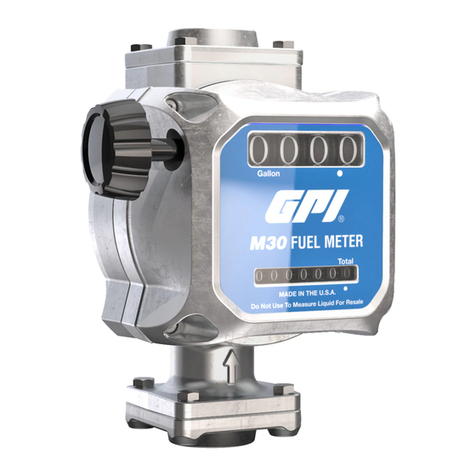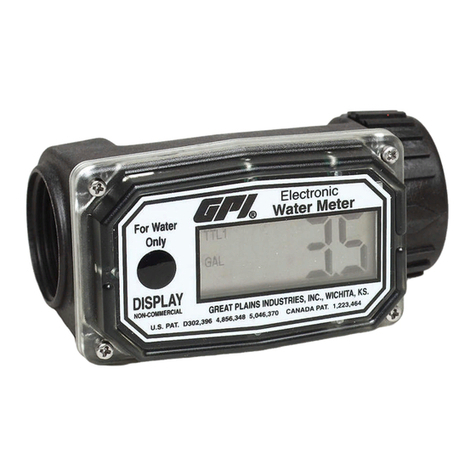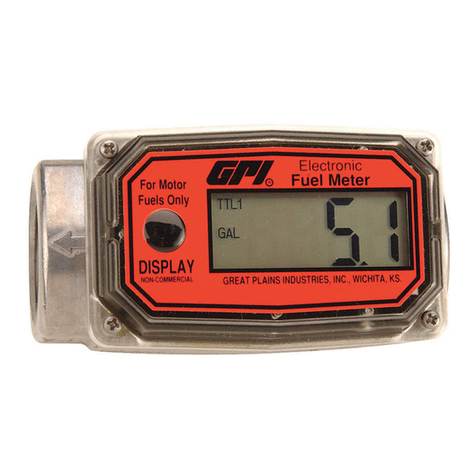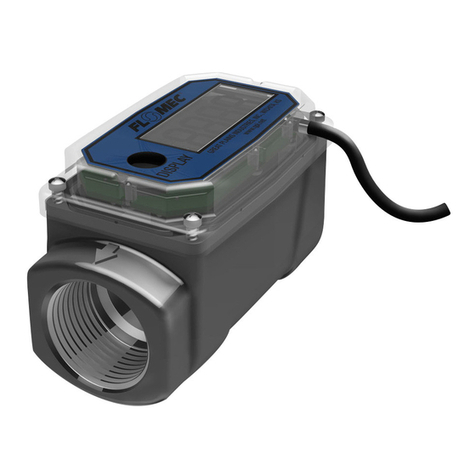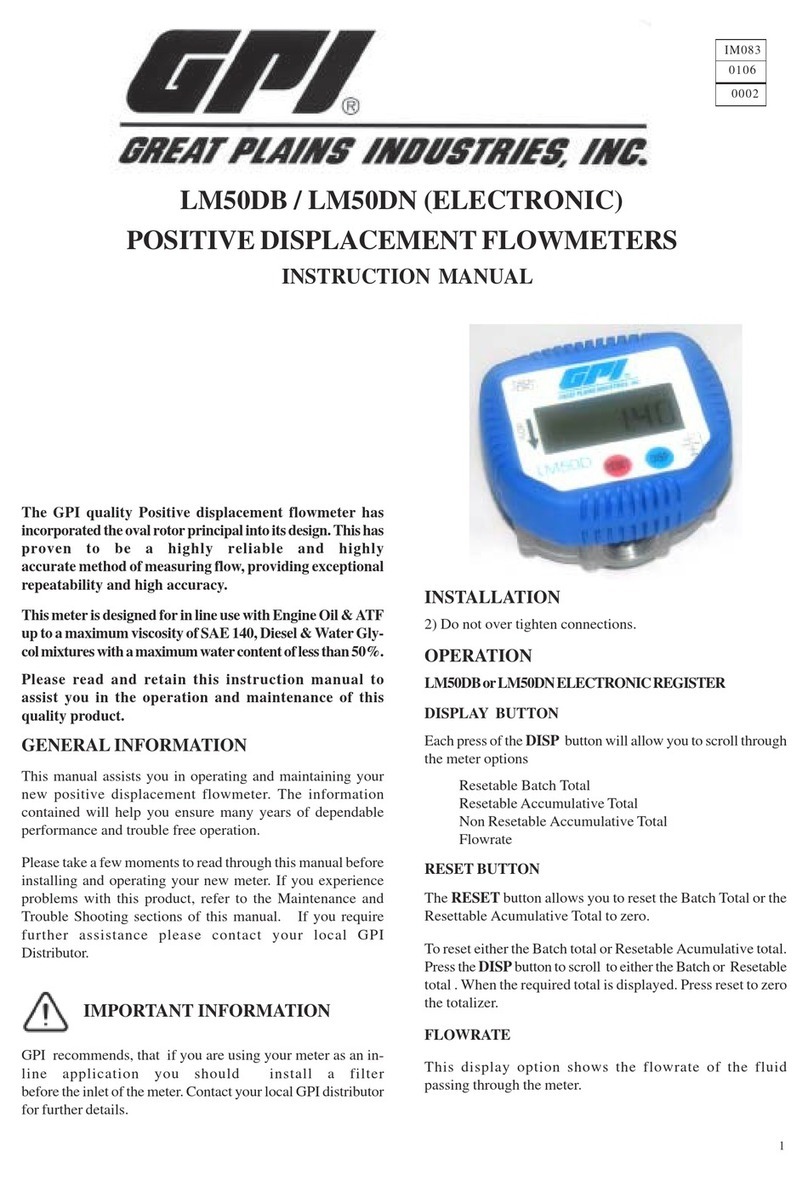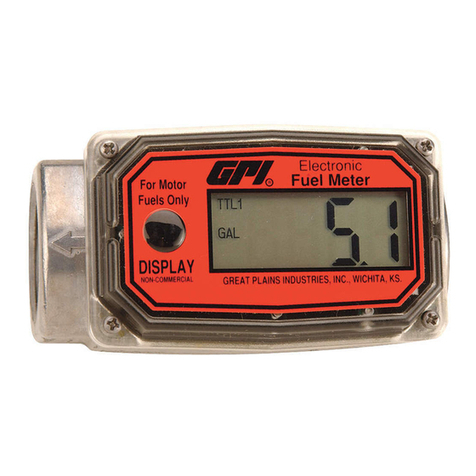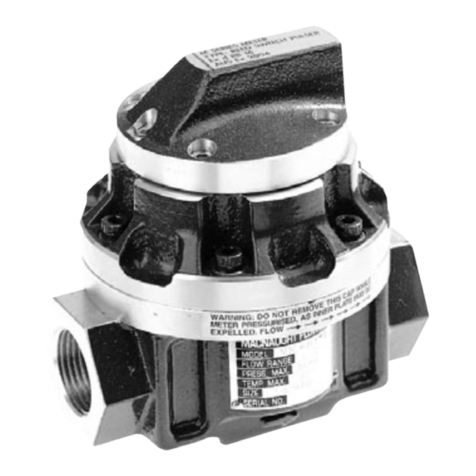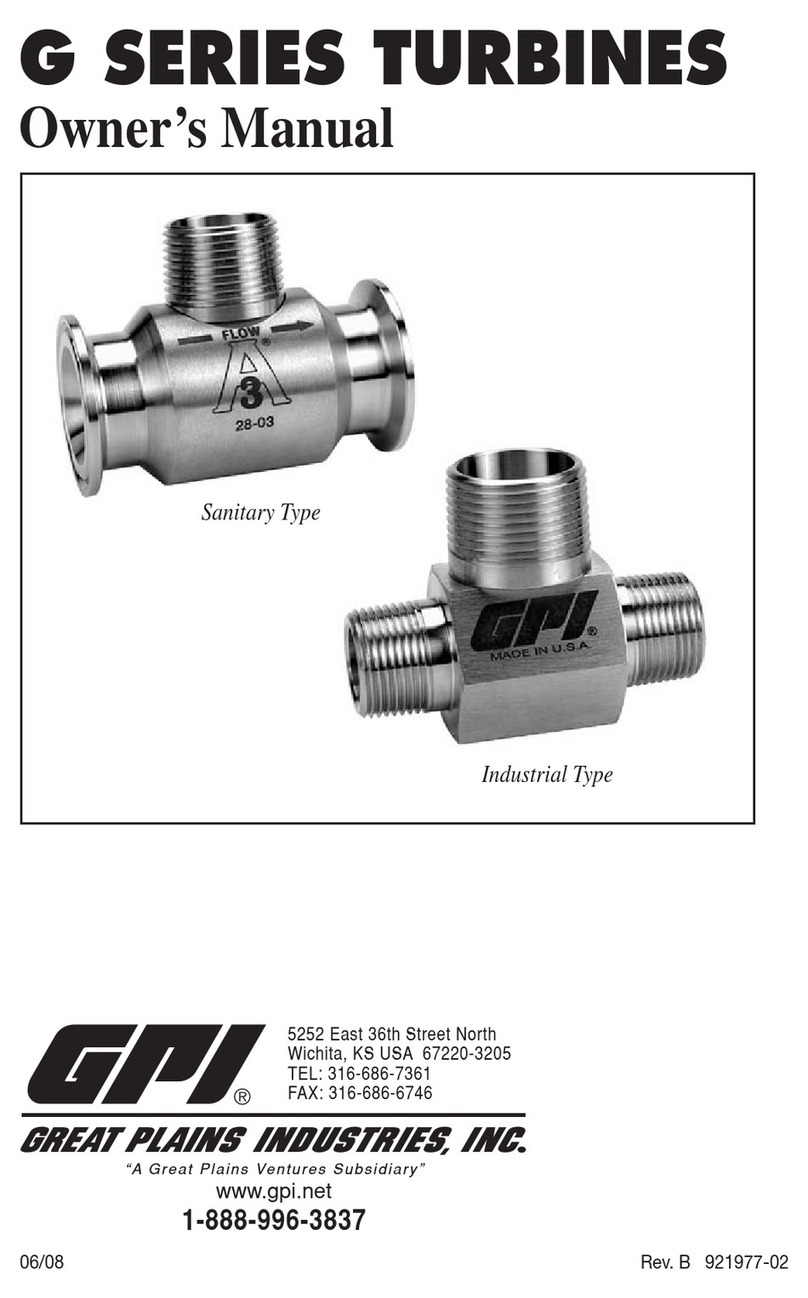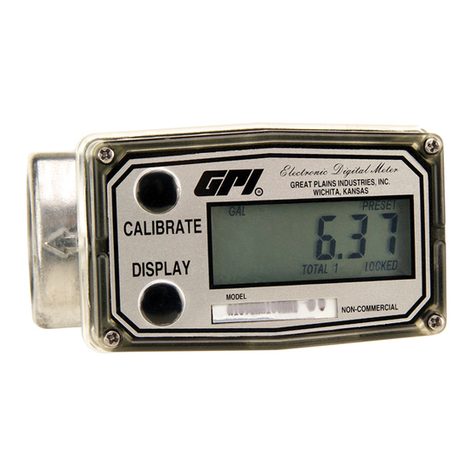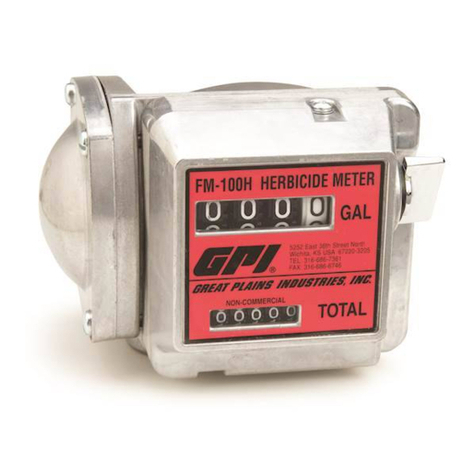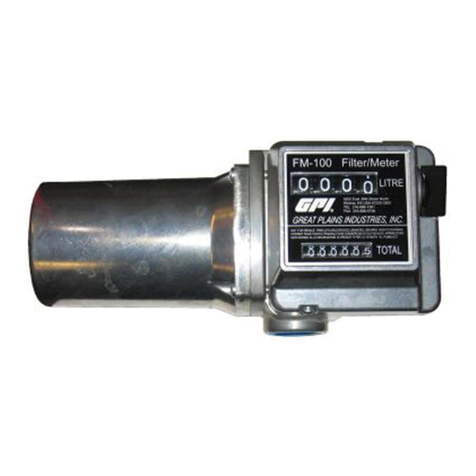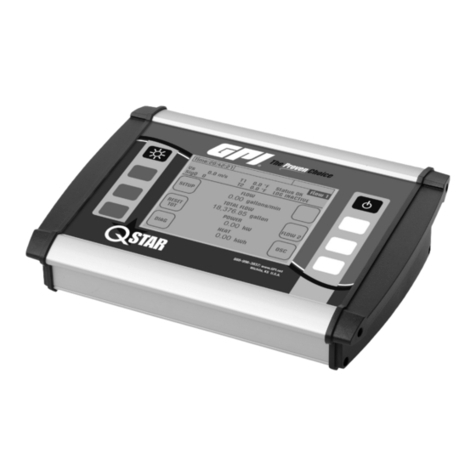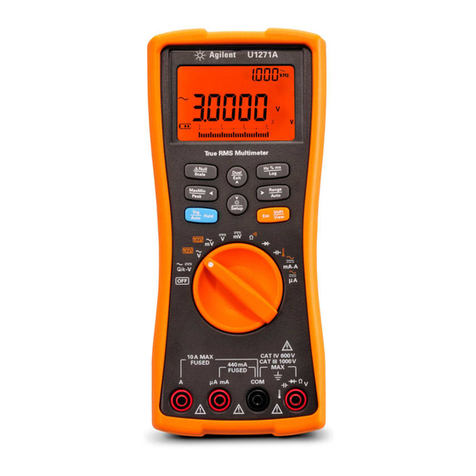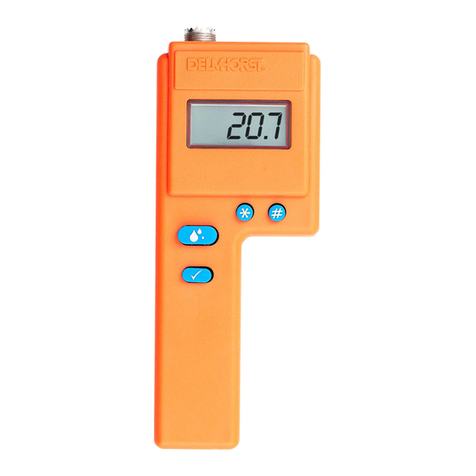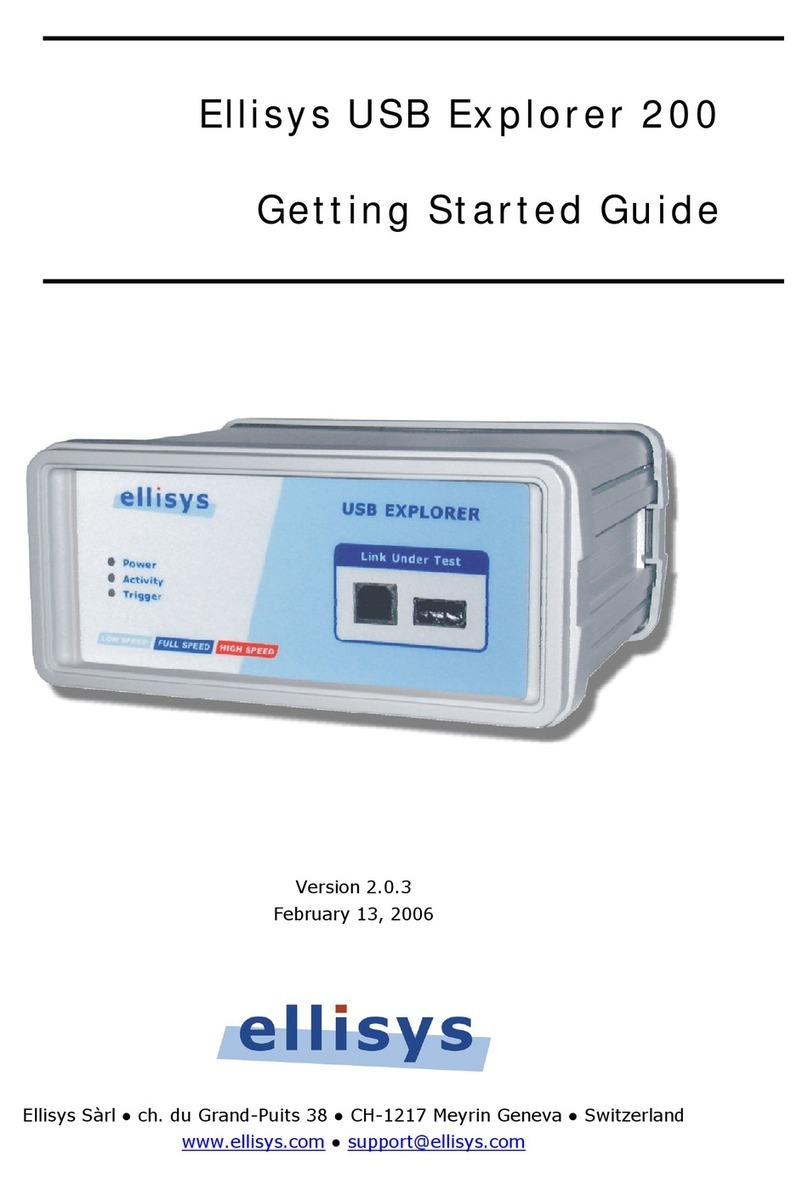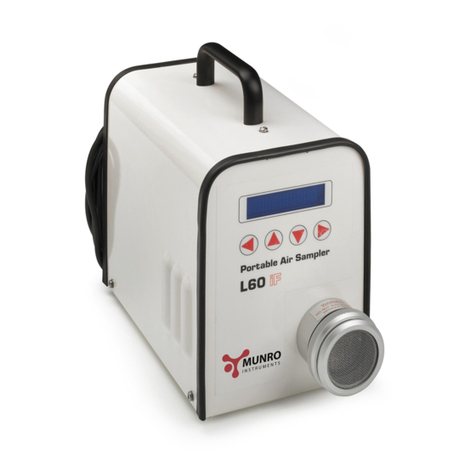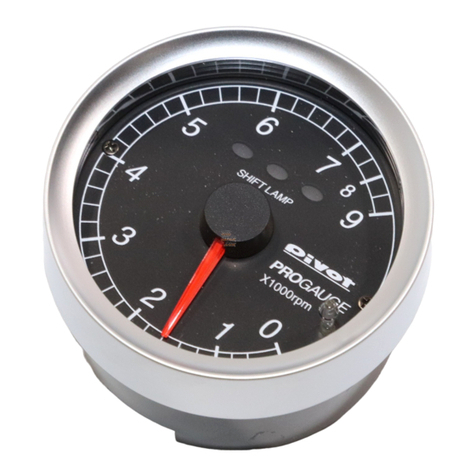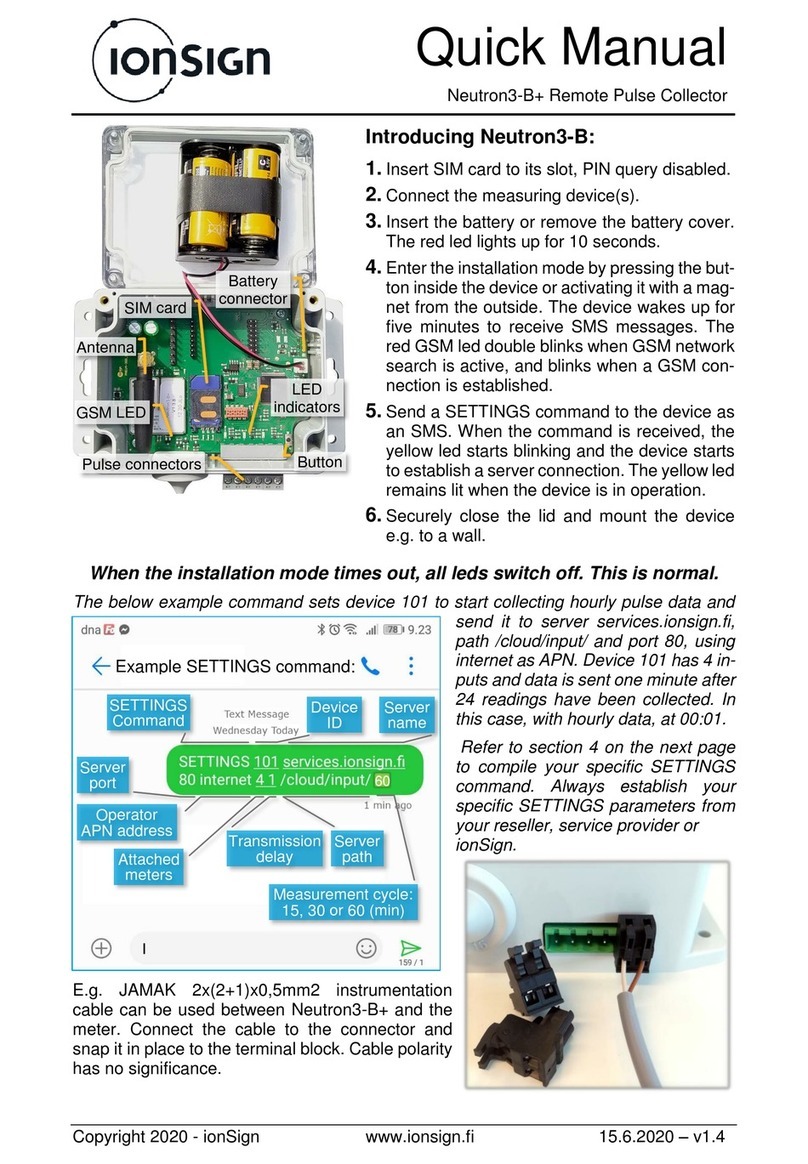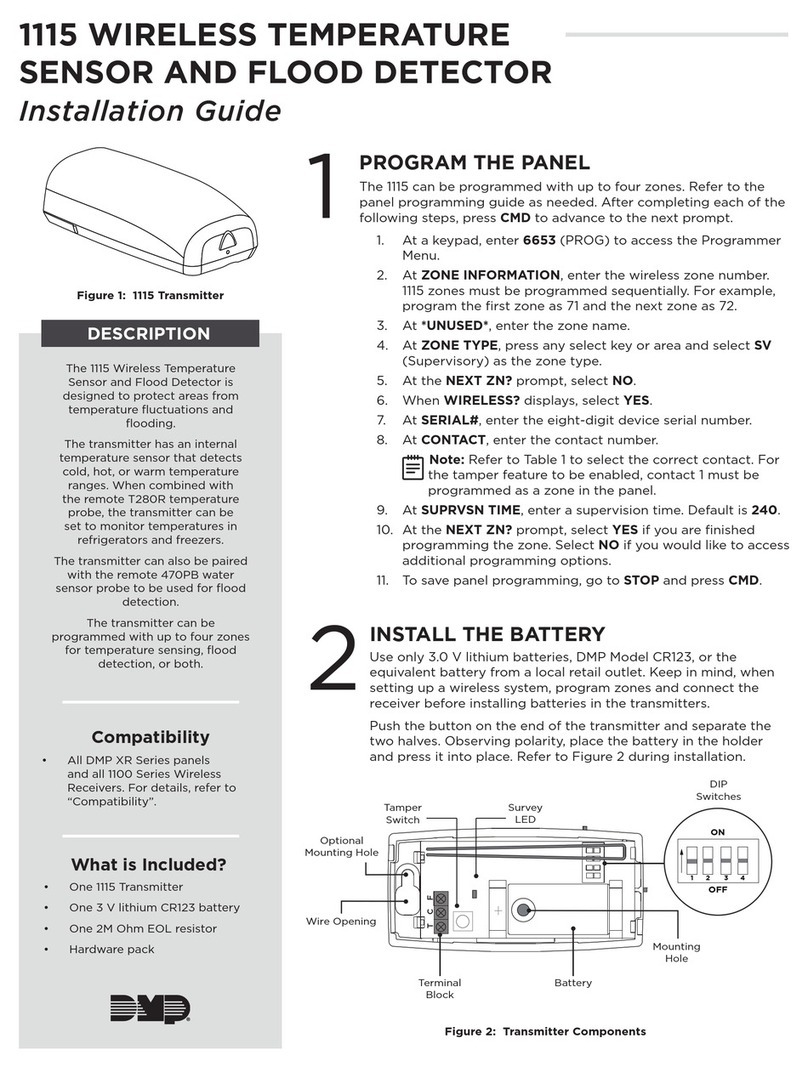GPI 03 Series User manual

03 Series
ELECTRONIC
DIGITAL METER
09/2021 920685-09 Rev N

2
Please save these instructions for future reference. Read carefully before attempting
to assemble, install, operate or maintain the product described.
Protect yourself and others by observing all safety information. Failure to comply with
instructions could result in personal injury and/or property damage.
Please refer to back cover for information regarding this product’s warranty and other
important information.
DO NOT RETURN THIS PRODUCT TO THE STORE!
Please contact Great Plains Industries, Inc.® before returning any product. If you are
missing parts, or experience problems with your installation, contact our Customer
Support Department. We will be happy to assist you.
Call: 800-835-0113
E ail: eters@gplains.co
SAVE FOR YOUR RECORDS
Model #: ______________________________
Serial #: ______________________________
Purchase Date: ________________________

3
TABLE OF CONTENTS
General Information ---------------------------------------------------------------- 4
General Safety Instructions ------------------------------------------------------ 4
Introduction --------------------------------------------------------------------------- 5
Before Installation ------------------------------------------------------------------- 6
Meter Installation -------------------------------------------------------------------- 8
Meter Maintenance ------------------------------------------------------------------ 9
Troubleshooting -------------------------------------------------------------------- 0
Meter Specifications --------------------------------------------------------------
Q9 Specifications ------------------------------------------------------------------ 3
Q9 Installation ----------------------------------------------------------------------- 6
Q9 Operation ------------------------------------------------------------------------ 7
Field Calibration ----------------------------------------------------------- 20
Computer Maintenance ------------------------------------------------- 23
Parts ------------------------------------------------------------------------------------ 24
Service --------------------------------------------------------------------------------- 25
Agency Approvals ----------------------------------------------------------------- 26
Declaration of Conformity -------------------------------------------------------27
Warranty ------------------------------------------------------------------------------ 28

4
To the owner . . .
Congratulations on receiving your GPI® Electronic Digital Meter. We are pleased
to provide you with a meter designed to give you maximum reliability and
efficiency.
Our business is the design, manufacture, and marketing of liquid handling,
agricultural, and recreational products. We succeed because we provide
customers with innovative, reliable, safe, timely, and competitively priced products.
We pride ourselves in conducting our business with integrity and professionalism.
We are proud to provide you with a quality product and the support you need to
obtain years of safe, depend- able service.
Victor Lukic, President
Great Plains Industries, Inc.
GENERAL INFORMATION
This manual will assist you in operating and maintaining your 03 Series Meter.
Differences in models are detailed in the Specifications Section of this manual.
Please take a few moments to read through this manual before installing or
operating your meter. If you need assistance, contact the dealer from whom you
purchased your meter.
If You Measure in Litres
This manual commonly refers to “gallons.” Depending on the model of 03 Series
Meter, “gallons” or “GAL” will represent US gallons. Your meter is factory calibrated
in gallons (GAL) and litres (L). Consider all references to “gallons” apply equally to
US gallons, and litres.
GENERAL SAFETY INSTRUCTIONS
This symbol is used through- out the manual to call your
attention to safety messages.
Warnings alert you to the potential for personal injury.
Cautions call your attention to practices or procedures that
may damage your equipment.
NOTES: Give information that can improve efficiency of operations.
It is your responsibility to make sure that all operators have access to adequate
instructions about safe operating and maintenance procedures.

5
GENERAL SAFETY INSTRUCTIONS (continued)
READ ME!
For your safety, review the major warnings and cautions below before operating
your equipment.
The apparatus enclosure may contain aluminum and is
considered to constitute a potential risk of ignition by
impact or friction. Care must be taken into account
during installation and use to prevent impact or friction.
Part of the enclosure is constructed from plastic. To
prevent the risk of electrostatic sparking the plastic
surface should only be cleaned with a damp cloth.
1. This meter is approved to handle only fluids that are compatible with the
meter’s housing material.
When metering flammable liquids, observe precautions
against fire or explosion. Do not meter in the presence of
any source of ignition including running or hot engines,
lighted cigarettes, or gas or electric heaters.
If handling hazardous liquids, always follow the
manufacturer’s safety precautions. Wear protective
clothing such as goggles, gloves and respirators as
instructed.
2. Always dispose of used cleaning solvents in a safe manner according to
the solvent manufacturer’s instructions.
3. During meter removal, liquid may spill. Follow the liquid manufacturer’s
safety precautions to clean up minor spills.
4.
Do not blow compressed air through the meter.
5.
Do not submerge the meter.
6.
Do not allow liquids to dry inside the meter.
7.
Do not use a wrench to install plastic meters. Hand tighten only.
8. For best results, always verify calibration before use.
INTRODUCTION
Your GPI Electronic Digital Meter is designed for measuring liquids. The meter
translates pulse data from the turbine into calibrated flow units shown on the
meter’s readout. Field replaceable batteries provide power.
All meters are tested and factory calibrated before shipping.
This manual refers to three families of meters: (Low Flow), (One Inch), and (Two
Inch). To further identify your particular model, refer to the Specifications Section
in this manual.

6
BEFORE INSTALLATION
Upon receipt, examine your meter for visible damage. Remove protective plugs
and caps for a thorough inspection. If any items are damaged or missing, contact
your distributor.
Make sure the meter model meets your specific needs. Refer to the Specifications
Section and confirm the following:
1. The flowrate is within the limits of your model.
2. The liquid is compatible with your meter’s material.
3. Your system’s pressure does not exceed the meter’s maximum pressure
rating.
Information specific to your particular turbine, including serial number and
manufacturing date is printed on the bottom of the turbine.
For your future reference, it might be useful to record this information in this manual
in case it becomes unreadable on the turbine.
Quick Start
If your installation is relatively simple and you have installed our Electronic Digital
Meter (EDM) meters before, you may use this section to quickly install and operate
your meter. This section is especially helpful to those measuring thin viscosity
fluids dispensed through a hose and nozzle.
If you complete this section and encounter difficulties, please refer to other
sections, as necessary.
NOTE: To accommodate different installations, the faceplate can be rotated 180
degrees. To do this, remove the four corner screws from the face of the
meter and lift the computer assembly from the turbine. Rotate the computer
assembly 180 degrees. Place on the turbine ensuring the seal is fully
seated. Secure the four screws.
Connections
1. To protect against leakage, make sure all threads are sealed with two or
three turns of thread tape or a sealing compound compatible with the liquid
being metered. (Figure 1)
Make sure the thread tape or
sealing compound does not
interfere with flow.
Figure 1

7
BEFORE INSTALLATION (continued)
Connections (continued)
2. Make sure the arrow on the outlet is pointing in the direction of the flow.
(Figure 2)
Figure 2
3. Tighten the meter onto the fittings. Use a wrench only on metal meters.
Hand tighten plastic meters.
Using a wrench on plastic meters could damage the
meter.
Verify Meter Accuracy
Before using, you should check the meter’s accuracy and verify calibration.
1. Make sure there is no air in the system by starting the flow until it runs
steadily. Then, stop the flow using a valve or nozzle.
2. If desired, hold down DISPLAY for 3 seconds to zero the meter’s Batch
Total. When zeros appear, release the button.
3. Verify meter accuracy before use. To do this, measure a known quantity of
liquid into a calibration container and compare the volume measured
against the readout. If necessary, field calibrate the meter. Refer to the
Calibration Section.
4. To ensure accurate measurement, remove all air from the system before
use. To purge the system of air:
a. Open the discharge valve or nozzle and allow fluid to completely fill
the system. Make sure the stream is full and steady and no air is
present.
b. Close the discharge valve or nozzle. Leave the system on.
c. Start normal operations. If necessary, zero the Batch Total.
Using the Meter
The meter display is on continually and always ready for use.
To determine the exact volume measured with each use, use the Batch Total
function. You can zero the Batch Total before measuring and monitor volume as it
flows through the meter, just like the gas pump at the service station as you fill up
your tank.

8
BEFORE INSTALLATION (continued)
Using the Meter (continued)
To zero the Batch Total, make sure the meter is on. Hold down the DISPLAY button
for 3 seconds until zeros appear. Release the button, start the flow, and watch the
volume on the readout.
When display becomes dim, faded or the low battery message (LOWBAT)
appears, the batteries need to be replaced. Reference the Computer Maintenance
Section for details.
METER INSTALLATION
Review the Before Installation and Quick Start Sections. Also consider the
following recommendations, especially if you are installing your meter in a piping
system. These suggestions will help maximize performance of your meter.
The meter can be mounted either vertically or horizontally. It should be field
calibrated in the same orientation in which it is mounted.
Avoid installing the meter in electrically “noisy” environments. If installed within 6
inches (15.2 cm) of large motors, relays, vehicle ignition systems, or transformers,
the meter’s accuracy can be adversely affected.
To avoid pulsation or swirl, use the following recommendations:
•For Low Flow or one inch meters, install with:
20 inches (51 cm) of straight pipe upstream and
5 inches (13 cm) of straight pipe downstream.
•For two inch meters, install with:
40 inches (102 cm) of straight pipe upstream and
10 inches (26 cm) of straight pipe downstream.
Flow straightening vanes installed upstream from the meter can reduce the
upstream pipe length.
Flow control valves upstream from the meter and within the straight pipe distances
given earlier can adversely affect meter accuracy. This is especially true when
measuring liquids with low vapor pressures such as fuels, oils and solvents.
If cavitation effects meter accuracy, a flow control valve on the downstream side
of the meter can provide a back pressure of 5 to 50 PSI (0.3 to 3.4 bar) to minimize
the problem.
Foreign material in liquid can clog the meter’s rotor. If the problem affects meter
accuracy or material coats the rotor, install screens to filter the incoming flow.
•For Low Flow meters use a 25-micron or .005 inch screen, 120 mesh.
•For one inch or two inch meters use a 500 micron or .018 inch screen, 35
mesh.
For maximum accuracy, the velocity profile of the flow entering the meter must be
uniform throughout the cross section of the pipe.
Make sure there are no leaks in the connections. To seal leaks, remove and
inspect the meter and replace the thread tape or sealant. Refer to the
Troubleshooting Section.

9
METER MAINTENANCE
During daily use, these meters are virtually maintenance-free.
When not in use, rinse, clean, and keep free of liquids to protect internal
components. If liquids have dried and caked on the rotor, refer to the Cleaning
instructions.
To Re ove
During meter removal, liquid may spill. Follow the liquid
manufacturer's safety precautions for clean up of minor
spills.
1. Ensure all liquid is drained from the meter. This could include draining the
hose, meter, nozzle or pipe.
2. Wear protective clothing as necessary; loosen both ends of the meter. Use
a wrench only on the meter’s flat metal surfaces.
Using a wrench on plastic meters could damage the
meter.
3. If the meter is not immediately installed again, cap the hose end or pipe to
prevent spills.
To Clean
During use, the meter should be kept full of liquid to ensure that drying does not
occur inside the meter. If drying or caking should occur, the rotor will stick or drag,
affecting accuracy. In this circumstance, cleaning is required.
To determine if the rotor is stuck or dragging, gently blow air through the meter
and listen for the quiet whir of the rotor.
Never blow compressed air through the meter. It could
damage the rotor.
To clean a stuck or dragging rotor, follow the procedures below.
1. Remove the meter from the hose or pipe following the directions above.
2. Apply a penetrating lubricant such as WD-40® or a recommended
cleaning solvent on the turbine’s rotor, shaft, and bearings. Allow it to
soak for 10 to 15 minutes.
Do not submerge the meter.
3. Carefully remove residue from the rotor using a soft brush or small probe
such as a screwdriver. Be careful not to damage the rotor and support.
4. When the rotor turns freely, install it again following the installation
instructions provided in this manual.
To Store
After thoroughly cleaning the meter, store it in a dry location.
Follow the liquid manufacturer’s instructions for the
disposal of contaminated cleaning solvents.

10
TROUBLESHOOTING
SYMPTOM
PROBABLE CAUSE
CORRECTIVE ACTION
A. METER IS
NOT
ACCURATE
1. Field Calibration not
performed properly
Field calibrate again or select
Factory Calibration.
2. Factory Calibration not
suitable for liquid being
measured
Perform a Field Calibration according
to Calibration Section.
3. Meter operated below
minimum flowrate
Increase flowrate. See Specifications
Section.
4. Meter partially clogged
with dried liquid
Remove meter. Clean carefully with
WD-40® or similar penetrating
lubricant. Make sure rotor spins
freely.
5. Turbine bearings
partially clogged with
dried liquid
Remove meter. Lubricate bearings
with WD-40® or similar penetrating
lubricant through small holes in
turbine supports. Make sure rotor
spins freely.
6. Teflon® tape or other
material wrapped
around rotor
Remove meter. Clear material from
rotor. Make sure rotor spins freely.
7. Installed too close to
fittings
Install correctly. See Installation
Section.
8. Installed too close to
motors or electrically
“noisy” environment
Install correctly. See Installation
Section.
B. READOUT
FADED,
BLANK OR
LOW BATTERY
MESSAGE
APPEARS
1. Batteries weak, dead
or not connected
2.
Computer defective
Remove computer and replace
batteries. Install computer again,
making sure that the seal seats
evenly around the computer and
turbine housing.
Contact the factory.
C. NORMAL
FLOWRATE
BUT METER
DOES NOT
COUNT
1. Field Calibration not
performed correctly
2. Rotor stuck or
damaged
3. Teflon® tape or other
material wrapped
around rotor
4.
Computer defective
Field calibrate again or select
Factory Calibration.
Remove meter. Lubricate turbine
bearings with WD-40® or similar
penetrating lubricant through small
holes in turbine supports. Make sure
rotor spins freely. If rotor cannot be
loosened, contact the factory.
Remove meter. Clear material from
rotor. Make sure rotor spins freely.
Contact the factory.

11
TROUBLESHOOTING (continued)
SYMPTOM
PROBABLE
CAUSE
CORRECTIVE
ACTION
D. REDUCED
FLOWRATE &
METER DOES
NOT
COUNT
1. Meter clogged with
dried liquids
Remove meter. Clean carefully with
WD-40®
or similar penetrating
lubricant. Make sure rotor spins freely.
E. CANNOT GET
METER INTO
FIELD
CALIBRATION
1. Wrong button
sequence
2. Computer circuitboard
defective
Hold down CALIBRATE and DISPLAY
for 3 seconds. Proceed with
calibration according to the
Calibration Section.
Replace computer. Contact the
factory.
F. METER
CONNECTIONS
LEAK
1. Meter installed
without thread sealant
2. Connecting threads
damaged
3. Meter housing
Remove meter. Wrap male
connections with 3 to 4 wraps of
thread tape or compatible sealing
compound.Install again.
Remove meter and inspect threads.
Replace damaged connections. If
meter threads are damaged, contact
the factory.
Inspect housing for cracks. If cracks
present,
contact
the
factory.
METER SPECIFICATIONS
The following specifications apply to
all models and materials.
Operating Temperature:
0° to +129°F (-18°C to +54°C)
(For temperatures up to 250°F,
contact factory)
Storage Temperature:
-40°F to +158°F (-40°C to +70°C)
Accuracy:
Low Flow models:
Factory Calibration: N/A*
Field Calibration: ±1.5% of reading
(Low Flow meters must be field
calibrated)
One inch and two inch models:
Factory Calibration: ±1.5% of reading
Field Calibration: ±1.0% of reading
Filter Screens:
Low Flow models:
Use a 25 micron or .005 inch
screen, 120 mesh.
One inch and two inch models:
Use a 500 micron or .018 inch
screen, 35 mesh.
Wetted Materials:
Rotor & Supports: Nylon
Signal Generators: Ferrite
Shaft: Tungsten Carbide
Journal Bearings: Ceramic
Retaining Rings: Stainless Steel
Housing: Nylon or Aluminum
Turbine Housing/Rotor Support
Materials:
Nylon Housing / Nylon
Aluminum Housing / Nylon

12
METER SPECIFICATIONS (continued)
The following specifications are
dependent upon housing materials.
Pressure Rating:
Aluminum: 300 PSIG (20.7 bar)
Nylon: 150 PSIG (10.3 bar)
Recommended Chemicals:
Aluminum Models:
Are recommended for use with
petroleum products, and should not
be used with water. Please verify
chemical compatibility with all
wetted parts.
Nylon Models:
Are recommended for use with
water or non-aggressive chemicals.
* Accuracy can vary up to ±5% depending
on installation and fluid type. Field
calibration is recommended for best
accuracy
Low Flow Model
1
Inch Model
2
Inch Model
Units US gallons
&
Litres
US gallons
&
Litres
US gallons
&
Litres
Flow Range 0.3 - 3 GPM
1
-
11
LPM
3 - 50 GPM
11
-
190
LPM
20 - 200 GPM
76
-
760
LPM
Threads
NPT
NPT
NPT
I
nlet
and
Outlet
1
inch
1
inch
2
inch
Internal
Diameter
1/4
inch
1
inch
2
inch
Design
Type
Paddlewheel
Turbine
Turbine
Minimum Readout
Total
0.001 0.001 0.001
Maximum Readout
Total
999,999 x 100 999,999 x 100 999,999 x 100
Pressure Drop at
Maximum
Flow
rate
2 PSIG @ 3 GPM
.14
bar
@
10
LPM
5 PSIG @ 50 GPM
.35
bar
@
190
LPM
7 PSIG @ 300 GPM
.48
bar
@
1,000
LPM
Dimensions:
- Length
- Height
-
Width
4 in. (10.2 cm)
2.5 in. (6.4 cm)
2 in. (5.1 cm)
4 in. (10.2 cm)
2.5 in. (6.4 cm)
2 in. (5.1 cm)
6 in. (15.2 cm)
4.25 in. (10.8 cm)
3 in. (7.6 cm)

13
Q9 COMPUTER ELECTRONICS
Q9 SPECIFICATIONS
MECHANICAL
Housing
Material
Transparent
Amorphous Nylon
Operating
Temperature
+0°F to +129°F (-18°C to +54°C)
If wider operating temperature ranges are desired,
reference information on GPI
®
Remote Kits.
Storage
Temperature -40°F to +158°F (-40°C to +70°C)
ELECTRICAL
Input PulseRate
Minimum Pulse In: 0 Hz
Minimum Coil Input: 10 Hz
Maximum Coil Input: 3 KHz
K-Factor Minimum: 0.001 pulses/unit
Maximum: >999,999 pulses/unit
Field Calibration
Correction
Minimum: -99.999%
Maximum: +99.999%
ReadoutTotals Minimum Display: 0.001
Maximum
Display:
999,999
(x100)
Field Calibration Yes
Power
Internal Power Supply: (2) Alkaline AAA batteries
@1.5-volts each
Battery
Life:
2+
years
STANDARD
FEATURES
INCLUDE
•
(2) Totalizing Registers
•Factory Calibration Curve
•
(1)
Field
Calibration
Curve
COMPUTER
ELECTRONICS
TERMINAL
CONNECTIONS
Figure 3

14
Q9 SPECIFICATIONS (continued)
DIMENSIONS
Length
“A”
Height
“B”
Height (Mounted)
“C”
Width (Widest Point)
“D”
3.40 in.
(8.6 cm)
0.85 in.
(2.1 cm)
0.72 in.
(1.8 cm)
2.14 in.
(5.4 cm)
Figure 4
COMPUTER DISPLAY FEATURES
Figure 5

15
Q9 SPECIFICATIONS (continued)
AGENCY APPROVALS
REMOTE KIT ASSEMBLY (113275-10)
NOTE: When a component with Approval Agency ratings is mated to another
component with the same Approval Agency ratings, the combination may gain
environmental approvals.
When one of the components has lessor or no Approval Agency ratings, the
resultant combination assumes the ratings of the lessor rated component.
If one component has no ratings, the resultant combination has no ratings.
Specific Conditions of Use
1. All computer assemblies are to be used with GPI battery 902004-02 except Q1,
Q9, and R9 versions, which use Energizer E92 / EN92, or Duracell MN2400
Alkaline batteries.
2. GPI remote kit assembly 113275-1 may be used with the meter when installed
in accordance with GPI Manual No.920507-01. GPI Remote Kit Assembly
113275-10 may be used with the meter when installed in accordance with GPI
Manual No. 920507-02.
3. The apparatus enclosure may contain aluminum, which is considered to
constitute a potential risk of ignition by impact or friction. Care must be taken
into account during installation and use to prevent impact or friction.
4. Part of the enclosure is constructed from plastic. To prevent the risk of
electrostatic sparking the plastic surface should only be cleaned with a damp
cloth.

16
Q9 INSTALLATION
PRODUCT DESCRIPTION
This computer electronics is designed specifically for use on GPI® Turbine
Housings. It is also designed to work with several accessory output modules.
The CMOS, microprocessor-based electronics have extremely low power
requirements and data retention capabilities in both RAM and ROM. Information is
clearly displayed on a large 6-digit LCD readout with three-point floating decimal
for totals from .001 to 999,999 (x1), 9,999,990 (x10), or 99,999,900 (x100). All
operations are easily accessed with the two buttons on the front panel.
In a GPI turbine meter, liquid flows through the turbine housing causing an internal
rotor to spin. As the rotor spins, an electrical signal is generated in the pickup coil.
This pulse data from the turbine is translated into calibrated flow units shown on
the computer's display readout.
INSTALLATION
Before installation, ensure your computer model meets your specific needs. Refer
to the Specifications Section to confirm required features. The model number of
your computer is displayed on the outside wall of the computer housing and also
inside the computer housing on the floor of the battery holder.
If you ordered your computer electronics with a turbine body, the electronics are
installed at the factory.
If you ordered your computer separately as a replacement, simply mount the
computer on your turbine body with the four screws at the corners of the faceplate.
Make sure the seal is fully seated before tightening the screws.
If you ordered the computer with a turbine body and an accessory module, please
review and thoroughly understand all installation instructions before proceeding.
All GPI turbine meters are designed to measure flow in only one direction. The
direction is indicated by the arrow on the turbine outlet port. If the computer display
is upside down in your installation, remove the four screws, turn the display 180
degrees and reinstall the screws. (See Figure 6)
NOTE: When rotating the computer
display, it is not necessary to
disconnect the pickup coil connector;
however, care should be taken to avoid
inadvertent strain on the connector
wires.
Figure 6

17
Q9 OPERATION
COMPUTER DISPLAY
All operations are revealed on the LCD using the large 6-characters in the top row
and smaller characters and symbols in the second row. These characters and
symbols indicate information regarding totals, flow, calibration, units of measure
and operational messages.
Push button operation varies dependent upon the various modes of operation, i.e.
Normal Operation mode and Field Calibration mode. Their operation will be
described in their respective sections.
ACTIVATE THE COMPUTER
When batteries are installed, the computer is on continuously and always ready to
perform. The computer is powered by field replaceable commercially available
batteries. Reference the computer maintenance section for battery replacement
details.
When batteries are initially installed or
replaced, the initialization routine will start
the LCD display blank, and then display
“HELLO” on the top row and “Q9Disp” on
the information row for one second.
(See Figure 7)
Figure 7
The LCD will then display “HELLO” on the
top row and “FW Vxx” on the information
row for one second. The Vxx will be the
version of the software installed on the
display. Example: “FW V03” indicates
firmware version 3 installed on the display.
(See Figure 8)
General
The computer maintains two totals; batch total and accumulative total. The batch
total can be reset to measure flow during a single use. The accumulative total
provides continuous measurement; and can only be reset by removing the
batteries, holding down the Display button, and replacing the batteries.
The button usage map on the next page is useful for understanding where the
various menus are located within the software programming and the route to get
to a specific menu. The map is followed by user instructions explaining each menu.
Figure
8

18
Q9 OPERATION (continued)
NORMAL OPERATION MODE
Button Usage Map – Nor al Operation Mode
BUTTON
Button Operation - Nor al Operation Mode
Display Button: Change between batch total and accumulative total.
When a total is displayed, pressing the Display button changes the top row of
large display digits between batch total and accumulative total. The information
row will change to the proper units and the corresponding icons will be shown, i.e.
TOTAL or BATCH TOTAL. (See Figures 9-1 and 9-2)
Figure 9-1 Figure 9-2

19
Q9 OPERATION (continued)
NORMAL OPERATION MODE (continued)
Display Button: Batch total reset.
When a batch total (see Figure 10-1) is displayed, press and hold the Display
button for 3 seconds; the software will display a three-second count down, and
then reset the batch total to zero. (See Figures 10-2 thru 10-4)
NOTE: If Display button is released prior to
count down completion, the software
returns to batch total screen.
(See Figure 10-1)
Figure 10-1
Figure 10-2
NOTE: After count down completes,
display will show 0.000 until user releases
the Display button. (See Figure 10-3)
Figure 10-3
NOTE: After the Display button is
released, the display will return to Batch
Total screen and will increment the total if
flow is detected. (See Figure 10-4)
Figure 10-4
NOTE: When the accumulative total is
displayed in Normal Operation Mode, it
cannot be reset using the Display button. If
the user attempts to reset it using the
Display button, the software will display a
“Reset Denied” message on the LCD until
the button is released. (See Figure 10-5)
Accumulative total can only be reset by
removing the batteries, holding down the
Display button, and replacing the batteries.
Figure 10-5

20
Q9 OPERATION (continued)
FIELD CALIBRATION MODE
Field Calibration Method
General
The field calibration method may be set by the user, and can be changed or
modified at any time using a field calibration method described in this section.
Totals or flowrate derived from the field calibration are being invoked when the
(FAC) icon is no longer visible below the 6-digit display.
Factory calibration settings are programmed into each computer during
manufacturing, using Stoddard test solvent at 70° F (21° C) for meters up to 1 inch.
Meters 1-1/2 inch and larger are factory calibrated using water at 70° F (21° C).
Settings are correct for light liquids such as water, gasoline or diesel. Readings
using the factory calibration (FAC) may not be accurate in some situations, for
example, "heavy" liquids such as motor oil, under extreme temperature conditions,
non- standard plumbing configurations or with fluids other than mentioned above.
For improved accuracy under such conditions, the computer allows for field
calibration, that is, user entry of custom calibration parameters. A "single point"
field calibration curve may yield acceptable accuracy when used in a non-standard
application, however, the computer is capable of programming a “five point” field
calibration curve.
NOTE: If the calibration method is changed when in calibration mode, i.e., not
using the default factory calibration (FAC), the programming will allow the user to
adjust the user programmable calibration table for the calibration method selected.
This is done by shunting the user to the “field calibration method entry menu”
specific to that calibration method upon exit from the calibration mode.
Verify Accuracy before Beginning Field Calibration
For the most accurate results, dispense at a flowrate which best simulates your
actual operating conditions. Avoid "dribbling" more fluid or repeatedly starting and
stopping the flow. This can result in less accurate calibrations. Make sure you meet
the meter's minimum flowrate requirements.
•Low Flow meter: 0.3 GPM
(1.1 LPM)
•1 inch meter: 3.0 GPM
(11 LPM)
•2 inch meter: 30 GPM
(113 LPM)
The use of a uniformly dependable, accurate calibration container is recommended
for the most accurate results. A five-gallon calibration container is available in the
parts section of this manual. For best results, the meter should be installed and
purged of air before field calibration. Due to high flowrates on meters 2 inch and
larger, it is strongly recommended that field calibration be completed with a
combination of volume and weight determined with fine resolution scales.
Other manuals for 03 Series
1
Table of contents
Other GPI Measuring Instrument manuals
Popular Measuring Instrument manuals by other brands
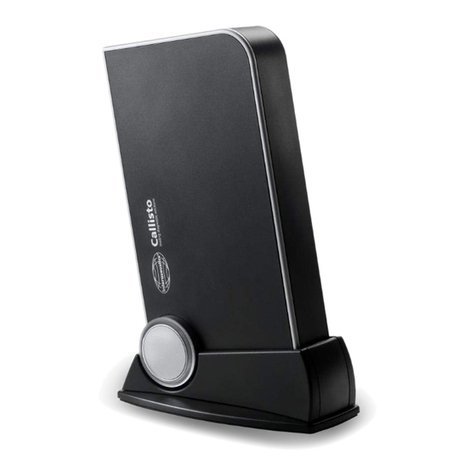
Interacoustics
Interacoustics Callisto Instructions for use

HORN
HORN FMOGne operating manual
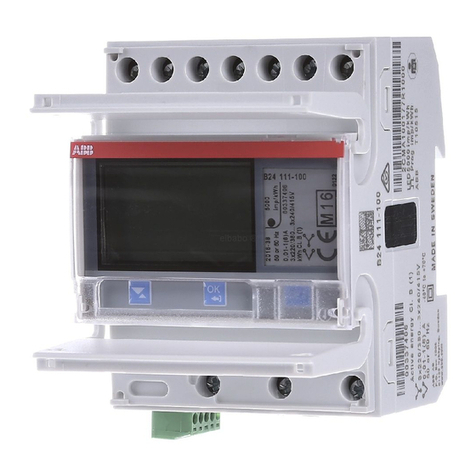
ABB
ABB B23 installation manual
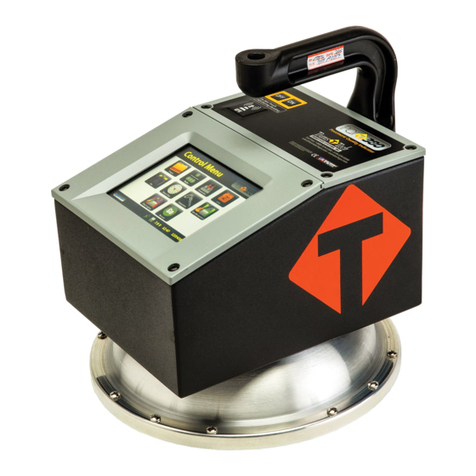
Transtech
Transtech PQI 380 Operator's handbook

CDI Meters
CDI Meters CDI 25 Installation and operating instructions
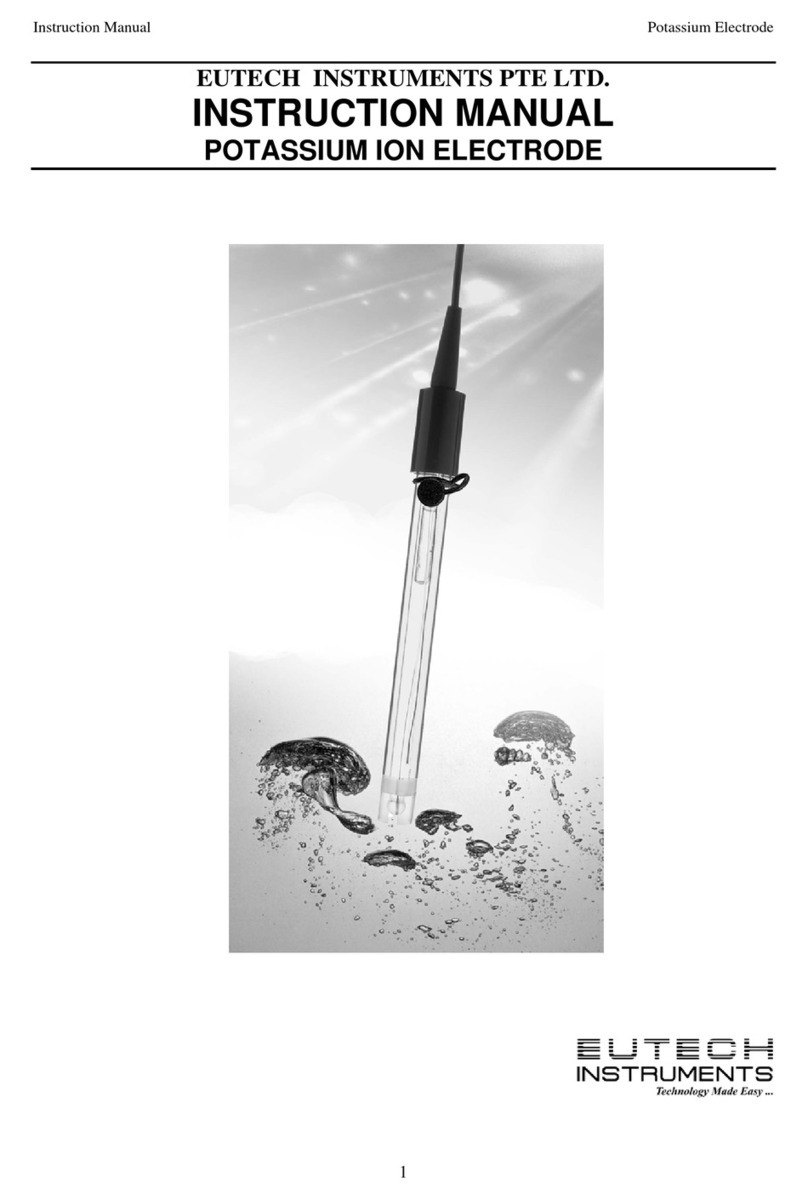
EUTECH INSTRUMENTS
EUTECH INSTRUMENTS POTASSIUM EPOXY instruction manual
